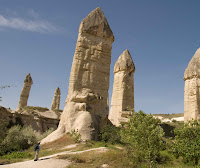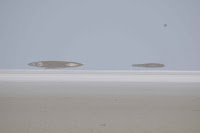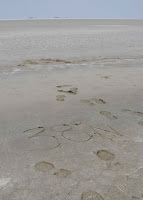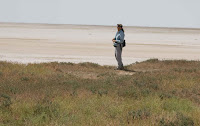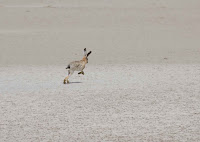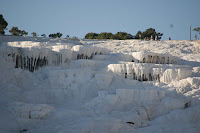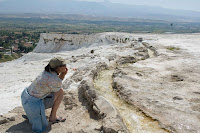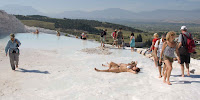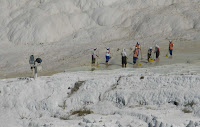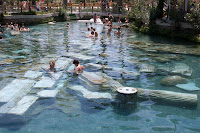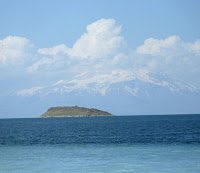 A vast inland sea with alkaline water whose strange chemistry produces large calcium carbonate structures underwater, in a dramatic setting with snow-covered mountain peaks,
A vast inland sea with alkaline water whose strange chemistry produces large calcium carbonate structures underwater, in a dramatic setting with snow-covered mountain peaks,  and a lake level that is thousands of feet above sea level...that sounds exactly like Mono Lake, our starting place for this 38th parallel exploration, but it also describes Lake Van, the largest lake in Turkey. This was our final stop on a 6-week trip that began in Portugal, took us across parts of Spain, Sicily, Greece, and for the last 15 days, the length of this very large country.
and a lake level that is thousands of feet above sea level...that sounds exactly like Mono Lake, our starting place for this 38th parallel exploration, but it also describes Lake Van, the largest lake in Turkey. This was our final stop on a 6-week trip that began in Portugal, took us across parts of Spain, Sicily, Greece, and for the last 15 days, the length of this very large country.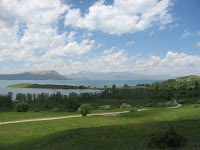
Lake Van also differs from Mono Lake in significant ways. It is much larger: a 270 mile shoreline (Mono's is about 40 miles); an average depth of 560 feet (today, Mono Lake averages about 60 feet deep) with a deepest point that is 1,480 feet! (Mono Lake is only about 150 deep at its deepest point).
Van holds a lot of water, but not much salt. It is primarily a "soda" lake, dominated by carbonates, also containing some sulfates (both key ingredients in Mono), but without our home lake's chlorides--i.e. dissolved table salt.
 There are fish in Lake Van, but only one species that can handle the unusual water chemistry; Mono Lake, of course, is much too salty for fish. The alkalinity of both lakes is fairly close, around pH 9.8 for Van and 10.2 for Mono. Because Van's water is less harsh, it does have the one kind of fish plus hundreds of species of plankton. Though we did not see many birds on the lake--just a few gulls--the literature says Van supports many migratory and nesting birds. Van even has calcium carbonate structures chemically related to Mono Lake's tufa formations, but Van's are out of sight in the depths, where cyanobacteria build aragonite towers up to 130 feet tall!
There are fish in Lake Van, but only one species that can handle the unusual water chemistry; Mono Lake, of course, is much too salty for fish. The alkalinity of both lakes is fairly close, around pH 9.8 for Van and 10.2 for Mono. Because Van's water is less harsh, it does have the one kind of fish plus hundreds of species of plankton. Though we did not see many birds on the lake--just a few gulls--the literature says Van supports many migratory and nesting birds. Van even has calcium carbonate structures chemically related to Mono Lake's tufa formations, but Van's are out of sight in the depths, where cyanobacteria build aragonite towers up to 130 feet tall!What a fitting place to end this segment of our around-the-world travels. We arrived
 by bus in the city of Van (38°29'N; 43°23'E) on the southeast shore of the lake.
by bus in the city of Van (38°29'N; 43°23'E) on the southeast shore of the lake. 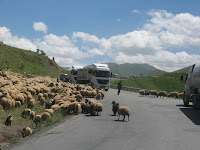 Adem, a medical student at the university in Van, was on our bus, and as so many other helpful Turkish people have done, he answered all our questions, was interested in our project, and when the bus deposited us in the city center, walked with us to find our hotel.
Adem, a medical student at the university in Van, was on our bus, and as so many other helpful Turkish people have done, he answered all our questions, was interested in our project, and when the bus deposited us in the city center, walked with us to find our hotel. 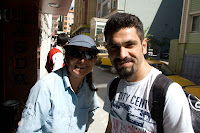 Following Adem's directions, we took a mini-bus out to the lakeshore where local kids were swimming.
Following Adem's directions, we took a mini-bus out to the lakeshore where local kids were swimming. 
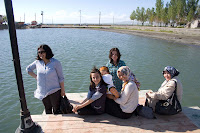 We felt the water, which was slippery, as expected. The water here, as at Mono Lake, has been used to wash clothes. We tasted a bit from our wet fingertips (like baking soda), and waded in the water.
We felt the water, which was slippery, as expected. The water here, as at Mono Lake, has been used to wash clothes. We tasted a bit from our wet fingertips (like baking soda), and waded in the water.There is so much we could have investigated here, given enough time. We understand that climate scientists are drilling down through Van Lake's bottom mud because they can find there a half-million years of climate data from the sedimentary record. We'd like to have seen more of the lake's bird life and volcanic features nearby, but this is our last night in eastern Turkey. Tomorrow we fly to Istanbul, spend one night, then fly all the way home for a break before finishing the around-the-world exploration by crossing Asia.





























